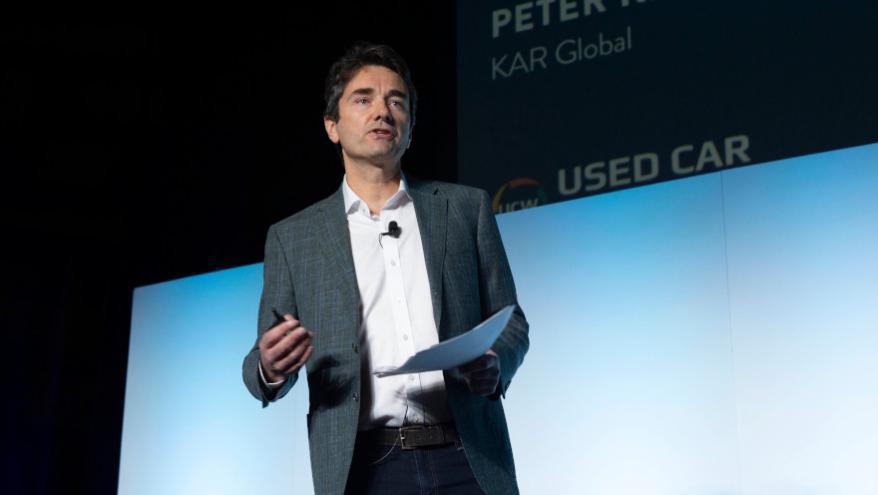KAR CEO sees promising signs of eventual off-lease recovery

File photo of KAR Global's Peter Kelly during his keynote presentation at Used Car Week 2019. Photo by Jonathan Fredin.
Off-lease has been the hardest hit segment of wholesale vehicle supply, and recent data suggests that could be the case for some time.
But KAR Global CEO Peter Kelly is encouraged by signs that off-lease volumes could eventually make a slow and steady return.
During opening comments of KAR’s third-quarter earnings call earlier this month, Kelly said he expects “a gradual increase” in overall wholesale volumes and that KAR’s position as a digital marketplace will help it “grow faster in the longer term” during the volume recovery.
“A key driver of the anticipated volume increase will be the supply situation relating to the volume of vehicles being offered by commercial sellers, particularly in the off-lease segment,” Kelly said.
“We continue to see fewer off-lease vehicles being returned compared to one year ago, but the level of that decline has lessened,” he said. “From our own analysis, the equity gap, which is the difference between the market value of maturing lease and the residual value in the lease contract, has declined meaningfully in the third quarter.”
Still, Kelly emphasized that equity gap will need to narrow further for off-lease vehicles to reach wholesale markets. But he said he believes leasing will remain a priority for dealers and automakers, and that KAR customers will sell more vehicles digitally than before COVID-19.
“I'm confident that leasing will remain an important element of OEM and dealer sales strategies, and that our strong footprint with off-lease vehicles will be a significant positive for this company in the years to come,” Kelly said. “Through my ongoing discussions with our customers, I believe that in the future our customers will seek to sell an even larger percentage of their portfolios digitally than they did pre-pandemic.”
Off-lease volumes, which has been the biggest contributor to overall industry volume declines, according to data that Cox Automotive shared last month. After reaching 2.5 million units in both 2018 and 2019 and remaining relatively steady at 2.4 million units in 2020, off-lease volume was cut in half during 2021 at 1.2 million units, the Cox data shows.
Volumes are expected to tank this year at 400,000 units, where they’ll likely stay in 2023 before climbing to a still-low 600,000 in 2024 and 1.0 million in 2025, according to Cox.
“The decline in off-lease returns, or the lease maturities that actually flow into the wholesale market, have produced the single largest decline in volumes in wholesale,” Cox Automotive chief economist Jonathan Smoke said in a conference call with the media and industry.
“This is a function of record values that have driven return rates to a historic low of 9% projected for 2022, when normal is greater than 60%. As values decline, the return rate will slowly improve, but even so, in future years, that higher return rate will be against much lower lease maturities,” said Smoke, who is among the speakers at Used Car Week in San Diego next week.
“A key takeaway from this is expect scarcity in 1- to 3-year-old vehicles for years to come,” he said.
Furthermore, Cox Automotive senior economist Charlie Chesbrough shared analysis later in the month on the short- and long-term impacts of the decline in leasing.
During the Q&A portion of the KAR earnings call, Kelly was asked about the impact of the off-lease fallout to KAR’s OPENLANE business.
Kelly reiterated that the decline in commercial volumes slowed for KAR in Q3 and he expects that to “bottom out.”
“We've talked about cost action; clearly we've looked at businesses like OPENLANE and other businesses, so some of the cost actions that we've taken are in those parts of the organization. So that’s something we continue to look at. Obviously, that's also an area where we've had conversations with customers on with respect to pricing and services … I would say that I think the key determinant of the future performance of that business, I'd say there are two factors,” Kelly said.
“One is the rate of decline of used-vehicle values and do off-lease vehicles start returning into the marketing funnel in greater volumes. I'd say we're seeing the very beginning of some evidence of that, but it's very small, it's not yet material, but it certainly has started to trend in that direction as vehicle values have come down,” he said.
“And the second one is the new lease originations, and obviously there will be fewer leases written in 2022 than there were in prior years,” he said.
The decline in lease originations, Kelly says, reflects lower new-car production and automakers finding they don’t need to incentivize vehicles — and incentives often push lease penetration, he said.
Those two market factors, however, are likely to change, Kelly said.
“I expect production of new vehicles to start to increase, albeit more slowly than experts have predicted. I also expect that in a more challenging economic environment, manufacturers will at some point have to start increasing their incentive spend on vehicles as well,” he said.
“And that will likely, I think, start to drive an increased lease attach rate over time. So again, I think leasing will remain a very important area for our business. I think it's one where we are significantly differentiated vis-a-vis our competition given our strong footprint with that segment. I would agree that that's not impacting our financial performance today like it was when the volumes were stronger. But I think we're sort of at or very, very close to the bottom, and I think it will improve over time.”
Kelly will be one of the speakers at the NAVIcon portion of Used Car Week. On Nov. 17, he sits down with Automotive Ventures CEO Steve Greenfield for a fireside chat on Digital Disruption: Making the Leap From Physical to Online.

 View The Latest Edition
View The Latest Edition

